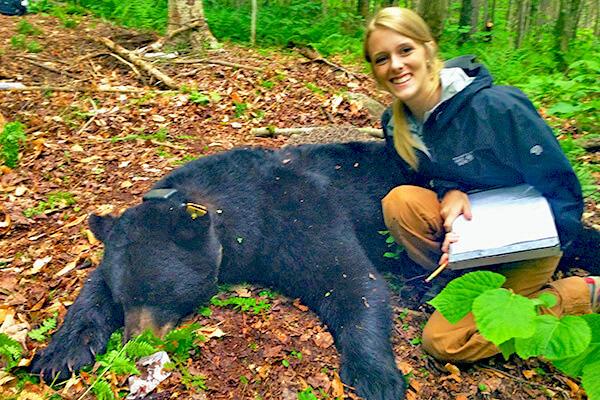Caitlin Drasher, undergraduate in the Wildlife and Fisheries Biology Program, from Manchester, Vermont, tells about her exciting volunteer work with the Vermont Department of Fish and Wildlife working up close with Vermont’s black bears. She is interning with Vermont Fish and Wildlife this summer and continues to assist with the bear study.
Last year, I had the amazing opportunity to volunteer with Vermont Fish and Wildlife on the Bear Wind Project. I spent my summer working with Vermont Bear Biologist Forrest Hammond, Wildlife Technician Jaclyn Comeau, and many other biologists with Vermont Fish and Wildlife and the U.S. Forest Service. I already had a summer job working at a state park, but I wanted to do some volunteering during my days off. As a Wildlife Biology major, I was interested in getting more experience in my field. I had briefly met Forrest Hammond at a talk he gave to UVM’s Wildlife Society, so I contacted him and we set up a day for me to volunteer in June. After that day, Forrest and Jackie invited me to volunteer whenever I was available.
The Bear Wind Project is aimed at determining how wind turbines affect the black bear population in Searsburg, Vermont. The wind project will be the first on federal land (managed by the U.S. Forest Service.) This area has been determined to be critical bear habitat, due to the amount of bear-scarred beech trees present, indicating heavy use by black bears on this particular ridgeline. The wind company is funding the study on black bears in return for being able to install turbines. Hopefully, the research on the bears in this area will help with wind project decisions in the future.
Our goal was to maintain enough collared bears to be adequate for the study, as some previously collared bears had lost collars or needed new ones. Ideally, twelve bears should remain collared. We dedicated a week or two to baiting trap sites and getting the bears used to coming into the areas. The following week was a trapping week when we hoped to get as many bears collared as we could. I learned that this is not an easy process, as some bears are smart enough to avoid traps or would accidentally set them off and get away. There was one site that had some very smart ravens; they would wait for us to leave after setting the trap, grab our bait, and set it off! There were many days with no bears, and there were days when we would have multiple bears and would need to work fast to attend to all of them.
Once a bear is trapped, they are tranquilized so that measurements can be taken without disturbing them or stressing them out. Their length, height, paw width, weight, and other measurements are recorded. If it is a bear that has not been captured before, a hair sample is taken for DNA purposes and a tooth sample is taken for aging. The bear is given a new collar if it does not already have one, or an existing collar is adjusted to fit properly. Ear tags are also given, so bears can be identified if their collars come off.
The collars help biologists track movement of the bears in and out of the study area. They connect to a satellite, which sends coordinates to a website that biologists use to monitor bear movements. Since the study is aimed at determining how the wind turbines will affect movement of bears, they are being studied a few years before, during, and after construction of the turbines.
My role in volunteering was to help out with whatever was needed. This meant hiking to scout out new trap sites, setting up bait sites and trap sites, and helping record measurements on trapped bears. In the fall, I helped Jackie with a hard mast survey, and in the winter, with scouting for bear dens and adjusting bear collars in the dens. This experience has been so rich, and I continue to volunteer whenever I have available time.
Through this volunteer experience, I learned that I have definitely found the right major for me. I am very interested in how our wildlife populations react to human impact. I also learned that I especially love doing field work, and I would be interested in field technician positions in the future. I am so glad that I contacted the biologists about coming along for a day, because that day turned into an entire summer of learning in the field about our state’s incredible black bears.
